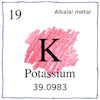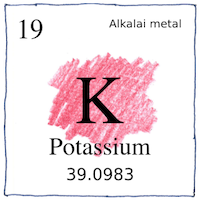London—Humphry Davy
elements

|
Potassium
Humphry Davy ran a current from the Royal Society’s voltaic pile through molten caustic potash, obtaining small mercury-like globules of pure metal—the first element isolated using electrolysis—which were covered with a white film or exploded or burned with a bright blue flame, and he named it potassium.
Atomic number 19
Potassium is in fertilizer (mainly as potassium chloride), in gunpowder (as saltpeter, potassium nitrate), and in baking powder (as cream of tartar, potassium bitartrate). Potash contains various potassium salts— potassium carbonate, potassium hydroxide, potassium chloride, potassium chlorate, potassium nitrate, potassium sulfate, and potassium permanganate. Potassium is an essential nutrient for plants and animals.
Essential stuff
One fifth of one percent of your body by weight is potassium. Insert the long list of its biological functions, without which you would be dead, here. Opposed to this analytic way of thinking: all things are one and you are one with all. But then you are one with the analytic just as much as with the synthetic.



Since ancient times, potash was obtained by putting leaf or wood ashes in a pot, leaching the ashes with water, and evaporating the solution. Saltpeter was obtained from decaying vegetation, sewage, or farmyard manure, also leached and evaporated. Potassium salts and sodium salts are chemically similar, so people did not realize that they were compounds of different elements.
See also in The book of science:
Readings in wikipedia:
Other readings: